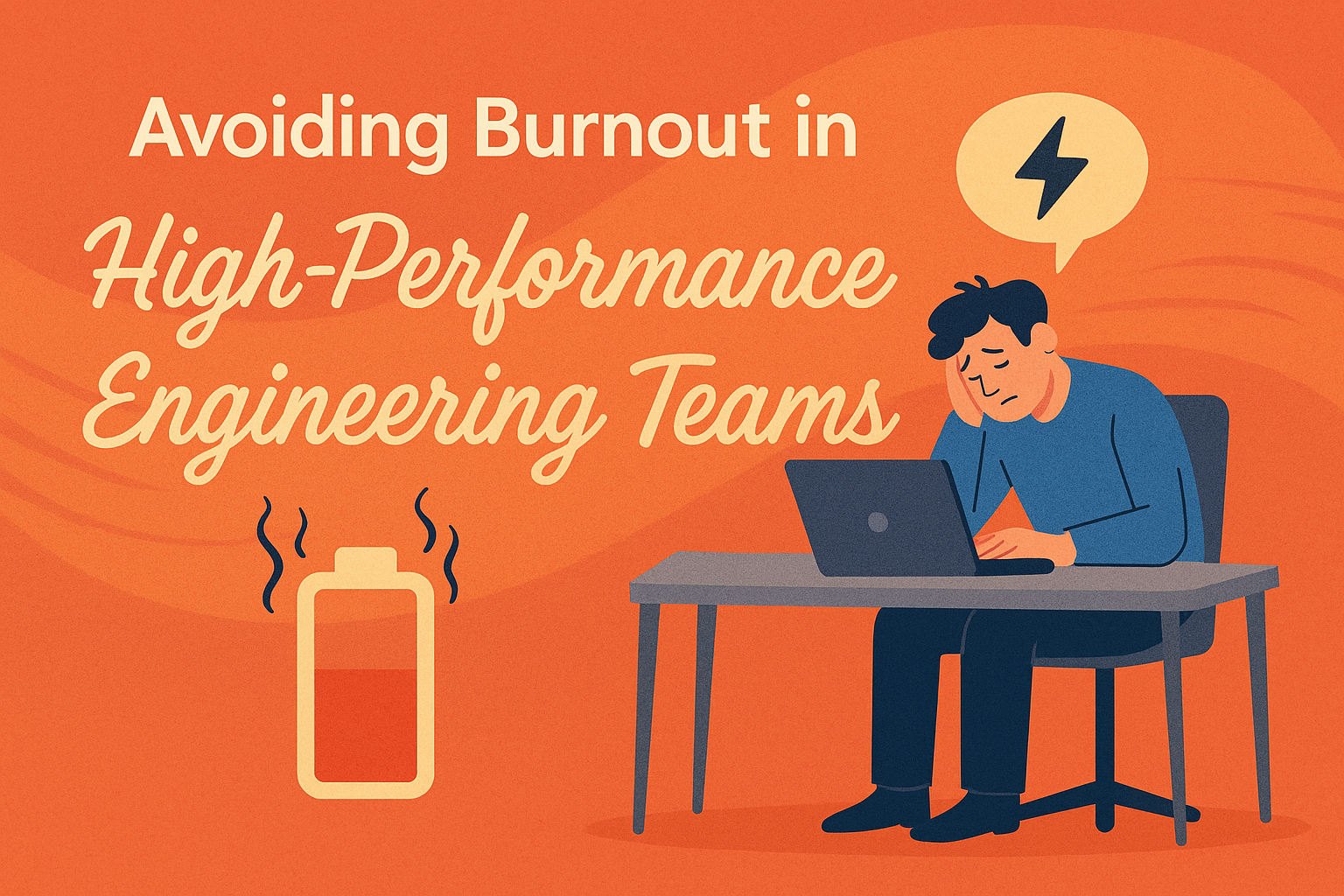Avoiding Burnout in High-Performance Engineering Teams

High-performance engineering teams are often celebrated for their velocity, innovation, and ability to ship at scale. But behind the impressive metrics and relentless delivery, there’s a growing risk that can quietly erode even the best teams from within: burnout.
Burnout doesn’t announce itself with a loud crash. It builds slowly - overwork, context switching, sustained pressure, lack of clarity or recognition. And when it hits, it hits hard: productivity drops, engagement plummets, attrition spikes, and psychological safety fractures.
The irony? The same qualities that make engineers high-performing - ownership, accountability, and a desire to solve hard problems - can also make them more susceptible to burnout when those traits are overstretched.
If we want our teams to perform over the long haul, avoiding burnout isn’t just a wellbeing concern. It’s a strategic imperative.
Understanding Burnout in Engineering
Burnout in engineering is often misunderstood. It’s not just about working long hours (although that can be a factor). It’s about sustained emotional, cognitive, and physical depletion caused by ongoing stress without adequate recovery or support.
Common signs include:
Chronic fatigue or disengagement
Declining quality or creativity in code
Withdrawing from collaboration or communication
Feeling cynical or disconnected from purpose
Reluctance to take ownership or make decisions
And the root causes? They vary, but often include:
Constant context-switching across tools, domains, and teams
Unclear or unrealistic expectations
Pressure to deliver without time to learn, refactor, or reflect
Lack of autonomy or recognition
The cultural glorification of hustle and heroics
High Performance Doesn’t Mean High Pressure
There’s a dangerous myth in engineering culture: that pressure equals performance. That “crunch time” is where heroes are made. That long hours and high stress are badges of honour.
But sustainable performance doesn’t come from burnout. It comes from balance.
The highest-performing teams I’ve worked with aren’t the ones working the longest - they’re the ones that:
Understand their priorities
Have space to think and grow
Know when to push and when to pause
Operate in environments of trust, clarity, and psychological safety
This is the culture we must build - not just for wellbeing, but for long-term excellence.
Practical Strategies to Avoid Burnout
Burnout prevention isn’t about yoga at lunchtime or free fruit in the kitchen. It’s about systemic change in how we lead, plan, and support our teams.
Here’s how to start:
1. Set Clear, Focused Goals
Ambiguity breeds anxiety. When everything is important, nothing is. High-performing teams need focus. Define clear, achievable objectives. Ruthlessly prioritise. Protect teams from thrash and scope creep.
2. Create Slack in the System
Not every sprint needs to be at 100% capacity. Build in time for tech debt, learning, and decompression. Allow space for reflection, not just delivery. Innovation rarely happens when people are running on empty.
3. Normalise Rest and Recovery
Model healthy behaviours - leaders taking holidays, teams pausing after intense cycles, avoiding out-of-hours heroics. Make it clear that rest is not a reward; it’s a requirement.
4. Invest in Developer Experience
Reduce cognitive load. Improve toolchains. Minimise friction. Empower teams to focus on solving problems, not wrestling with broken processes or bloated systems.
5. Encourage Autonomy and Mastery
Give teams control over how they work. Support experimentation and continuous learning. Celebrate craft, not just speed.
6. Measure Health, Not Just Output
Balance performance metrics (velocity, lead time) with health indicators - engagement surveys, flow time vs wait time, context-switch frequency, 1:1 feedback. What gets measured gets managed.
7. Build a Culture of Psychological Safety
People need to feel safe to speak up, say “I’m struggling,” or push back on deadlines. Teams thrive where there’s trust, empathy, and permission to be human.
Key Takeaways
✅ Burnout isn’t a sign of weakness - it’s a signal the system needs attention.
If your highest performers are burning out, the cost isn’t just human - it’s strategic.
✅ High performance should be sustainable.
Pace matters more than speed. Resilience beats heroics.
✅ Leaders shape the environment.
Protect focus, model healthy norms, and listen actively to how your teams are really doing.
✅ Small changes compound.
Reducing meetings, refining processes, investing in better tooling - these all chip away at burnout risk.
✅ Wellbeing and performance are not at odds.
They are mutually reinforcing when done right.
Final Word
Burnout prevention isn’t about lowering the bar - it’s about raising it smarter. It’s about creating environments where people can do their best work without sacrificing themselves to do it.
Because the best engineering teams don’t just ship fast - they last. They build things that matter, and they bring each other along for the journey.
Let’s build for the long game. Let’s build individuals and teams that thrive.
Engineering leader blending strategy, culture, and craft to build high-performing teams and future-ready platforms. I drive transformation through autonomy, continuous improvement, and data-driven excellence - creating environments where people thrive, innovation flourishes, and outcomes matter. Passionate about empowering others and reshaping engineering for impact at scale. Let’s build better, together.
